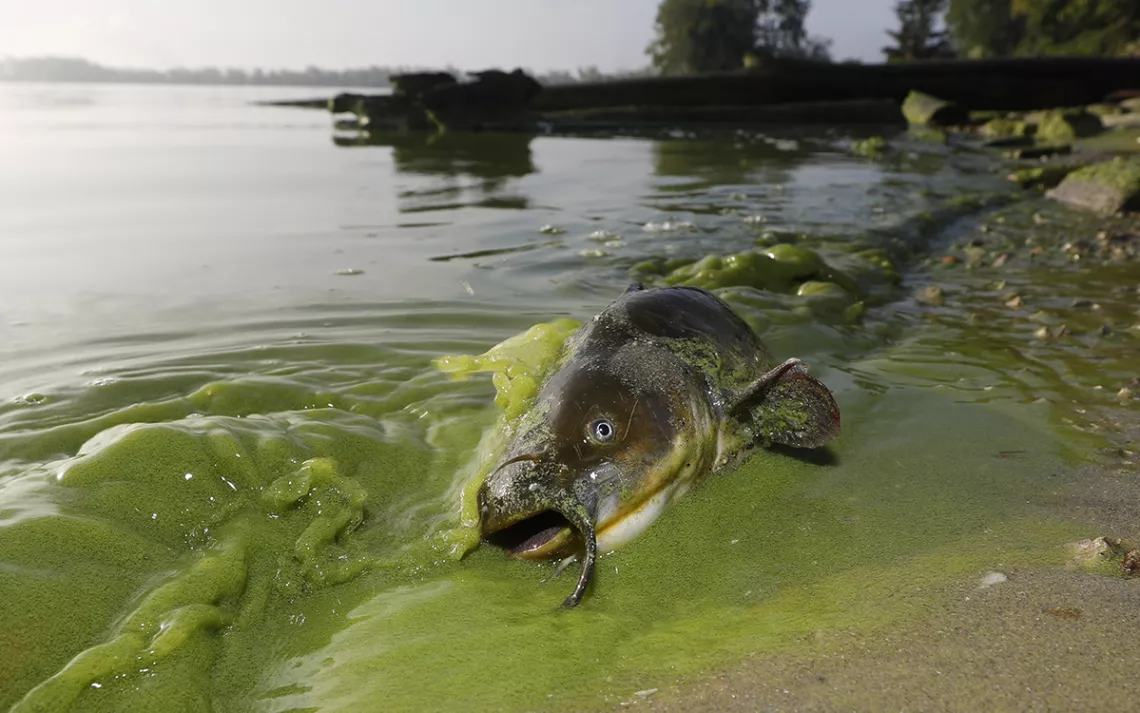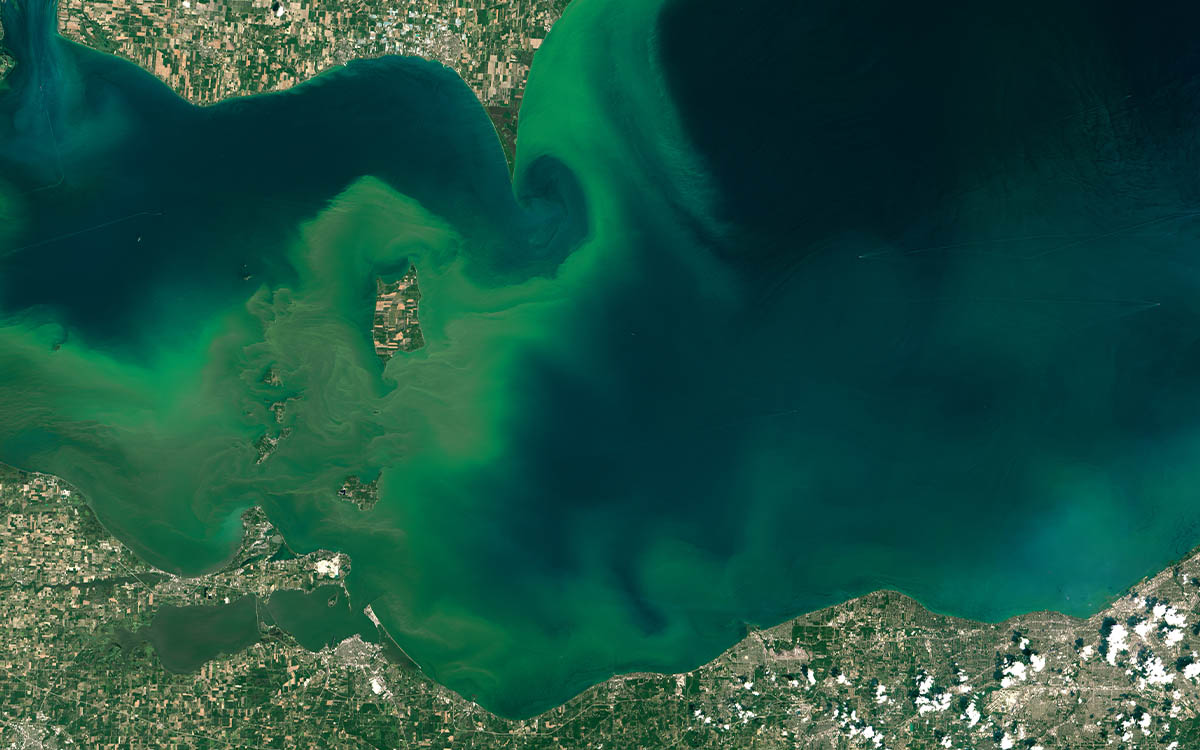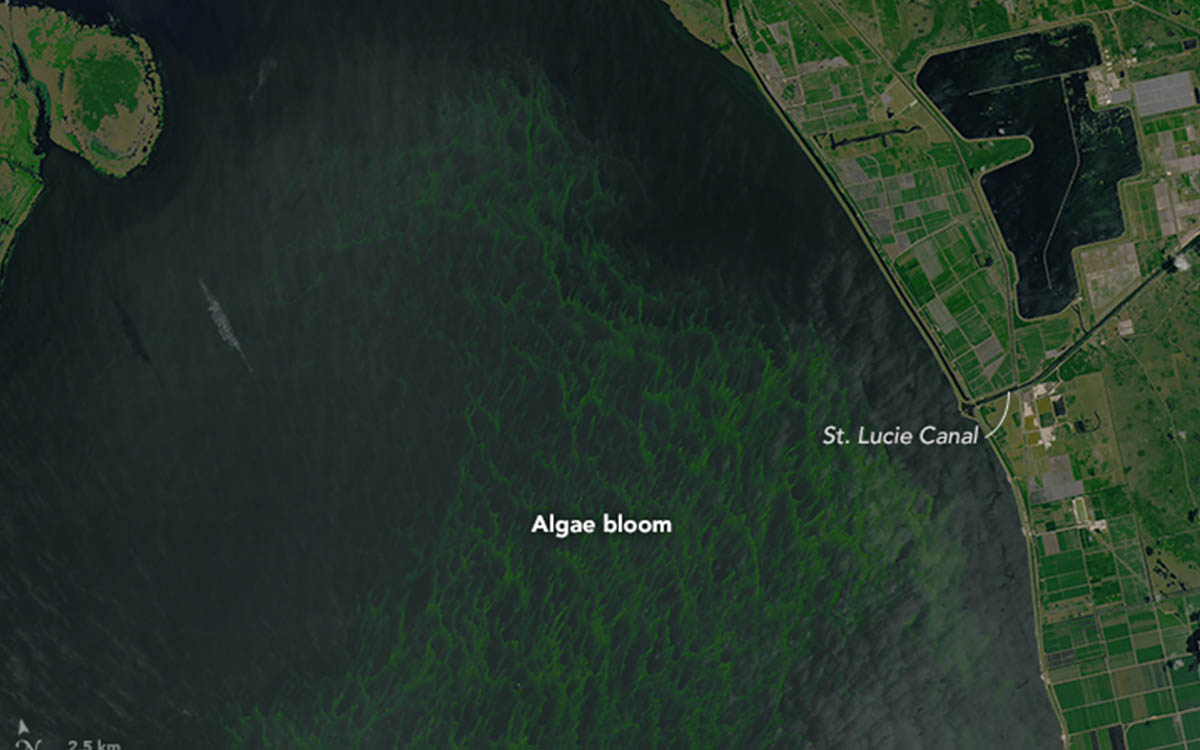Warming Lakes Worldwide Could Mean More Toxic Algal Blooms
A first-ever global survey of lakes links climate change to increased blooms

Algae-filled waters of North Toledo, Ohio, in September 2017 | Photo by Andy Morrison/The Blade via AP Photo
In August last year, Florida governor Rick Scott declared a state of emergency after a crimson “red tide” of toxic algae flooded the waters of the Gulf, overwhelming popular beaches, shutting down tourism, and making it difficult for coastal residents to breathe. The blooms were linked in part to a US Army Corps of Engineers decision to release huge amounts of nutrient-laden water from Lake Okeechobee after Hurricane Irma dumped record rainfall in the area.
This past July, after a particularly wet spring, NOAA predicted that Lake Erie, the fourth-largest of the Great Lakes with a watershed that provides drinking water to 11 million people, would suffer yet another significant toxic algal bloom—a reoccurring problem since 2011. NOAA’s predictions proved accurate: One month later, a film of noxious bright-blue-green algae accompanied by a cloying, pungent smell spread to some 620 square miles of the lake’s surface, forcing multiple beachside communities to issue health and contamination advisories and to post signs warning beachgoers to avoid all contact with the water. The algae contained a bacteria that produces the toxin microcystin, which can cause liver damage, dizziness, and vomiting. Several dogs died from exposure.
These are two of a number of unusually large algal blooms that have recently commanded public attention, media coverage, and scientific scrutiny, leaving some to wonder: Are these incidents just receiving more attention, or are toxic algal blooms getting worse?
A new study of algal bloom activity in dozens of freshwater lakes around the world provides an answer: For the past 30 years, lakes nearly everywhere have been experiencing more frequent and severe toxic algal blooms—and a changing climate is one reason why.
Researchers at the Carnegie Institution for Science used satellite data collected over the past three decades to examine large freshwater lakes across six continents. They searched through more than 72 billion data points to identify statistically significant patterns in algal bloom intensity and found that the severity of algal blooms has increased in over two-thirds of the 71 large lakes studied across 33 countries.
Carnegie’s global survey of freshwater lakes is the first of its kind, with research until now focusing only on individual lakes or specific regions.
Local factors such as higher nutrient content from agriculture runoff, or aggressive land-use practices like urban development often determine whether conditions are ripe for an algal bloom in a particular lake. But the study revealed one consistent factor that amplifies those conditions: rising temperatures caused by climate change. Researchers found that the few lakes where algal bloom activity had decreased and the water quality improved had either warmed very little or actually been cooling instead of warming.
“We looked at different factors such as temperature, precipitation, fertilizer use, and we found that it was really a combination of these . . . in any particular lake,” Jeff C. Ho, a researcher at Carnegie and lead author of the report, told Sierra. The findings were first published in the journal Nature. “Lakes are very heterogenous. But the finding that the lakes that had improved in water quality had warmed less was an important one, because that suggests we have to start understanding how climate change is going to interact with these local factors moving forward.”
Researchers employed cutting-edge technology to conduct this first-ever global survey of freshwater lakes and algal blooms. Carnegie’s Jeff C. Ho and Anna M. Michalak and NASA’s Nima Pahlevan applied algorithms to data collected from NASA and the US Geological Survey’s Landsat 5 near-Earth satellite, which captured images of the planet’s surface between 1984 and 2013. The data was made available through a partnership with Google Earth Engine—a platform developed to enable scientists to process a petabyte-scale level of satellite imagery. Before Google Earth Engine, it was incumbent on users to download individual satellite images and do all the processing themselves. The Google Earth Engine platform gave the researchers the ability to query all the Landsat 5 near-Earth satellite archive from 1994 to 2013 at the click of a button.

Algal bloom in Lake Erie, July 2019 | Photo courtesy of NASA

Algal bloom in Lake Okeechobee, May 2016 | Photo courtesy of NASA
“For example,” Ho said, “you can query all satellite images over Lake Erie, apply a number of different algorithms in the literature on it . . . then relate that to the amount of phytoplankton intensity on the ground and apply that on every image back to 1984, then generate time-series information to evaluate.”
The researchers found that on a global scale, increased rainfall also contributes to local conditions and can catalyze the kind of significant toxic algal blooms that threaten the environment and public health. Any of a number of factors can precipitate a toxic bloom, such as fertilizer runoff from agriculture during rainfall. Scientific studies have tried to determine to what extent temperature, rainfall, fertilizer from farming, or a combination of all of the above have the potential to cause a toxic bloom in large freshwater lakes. Different conditions at different lakes will often determine whether a waterbody experiences a toxic bloom. Increases in warming and rainfall, however, can amplify those conditions, according to the report.
“It’s an intersection between what we’re doing locally in terms of agriculture and land use and what we’re doing globally in terms of climate. When you put those pieces together, they result in outsize consequences for water quality,” Michalak, a coauthor of the report, told Sierra. “No matter where you look in the world, odds are that these blooms . . . are getting more intense."
Lake Erie is a prime example. When researchers examined the Lake Erie basin, they found that there has not been a huge shift in how much land is being used for agriculture or what crops are being grown. They determined instead that a series of years with very intense springtime storms—something that climate models have predicted for the Great Lakes region—exacerbated the impact from ongoing agriculture practices—flushing nutrients off the fields into the lakes and feeding these intense blooms.
As algal blooms become more common and widespread, the impacts to the environment and public health will become more severe. According to the Centers for Disease Control and Prevention, exposure to algal blooms can cause skin, eye, and throat irritation, headaches, diarrhea, and flulike and neurological symptoms. Toxic algal blooms can dramatically affect the availability of drinking water—in 2014, an algal bloom in Lake Erie contaminated the entire water supply for Toledo, Ohio, leaving half a million people without water. Water for irrigation, fishing, recreation, and tourism can also be impacted. According to the Carnegie study, freshwater algal blooms in the United States result in a loss of $4 billion each year.
The study makes clear that in addition to warming, changing rainfall patterns influence water quality. Climate change will make the hydrological cycle more intense, with wet places getting wetter and dry places getting drier. The report identifies global hotspots like India and China, where intensive land use combined with intensifying rainfall make algal blooms much more likely to occur.
“We know the direction in which rainfall patterns are trending in different parts of the world,” Michalak says. “We know how quickly different parts of the world are warming. We need to be designing water management based on what we know future conditions will be, and that’s very different from how natural resource management has occurred up to this point.”
 The Magazine of The Sierra Club
The Magazine of The Sierra Club



